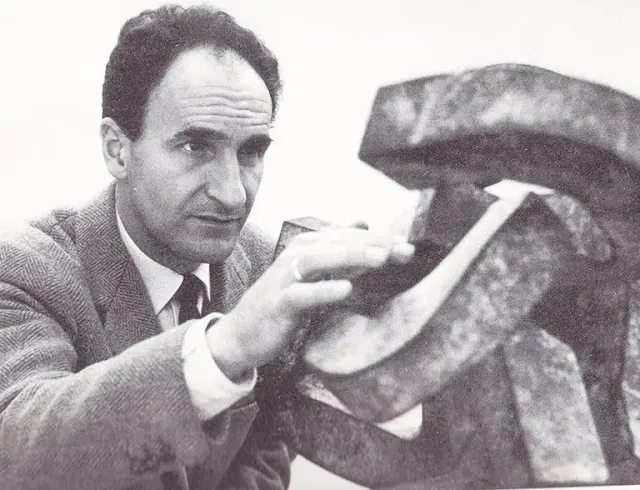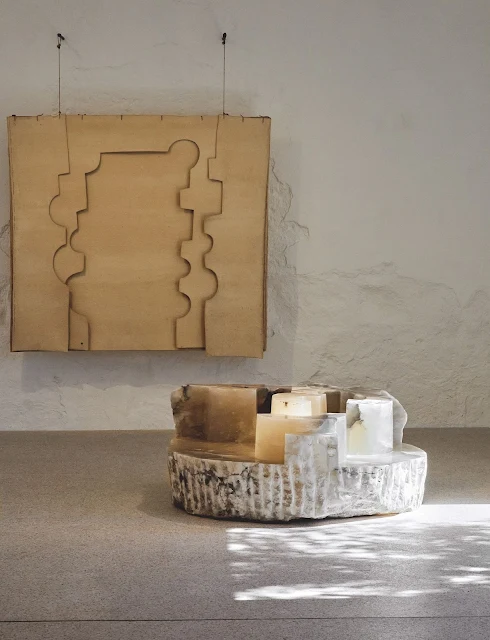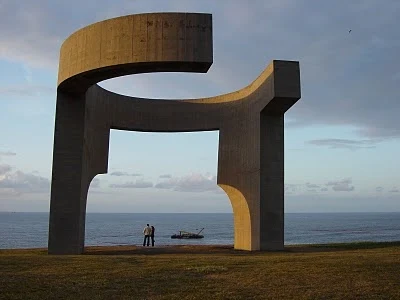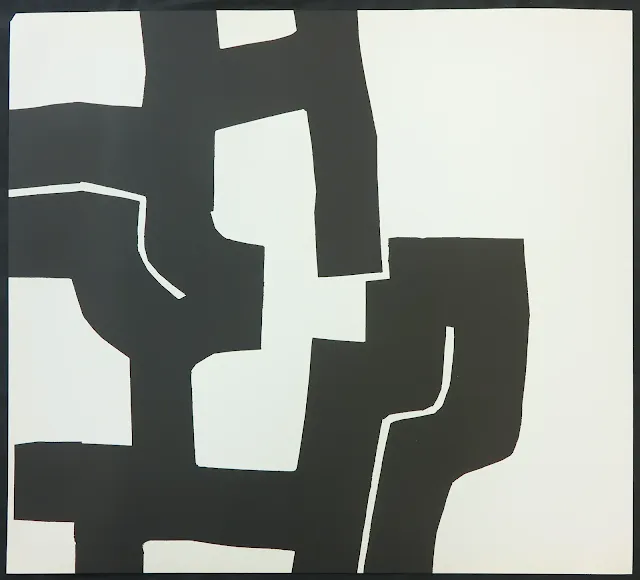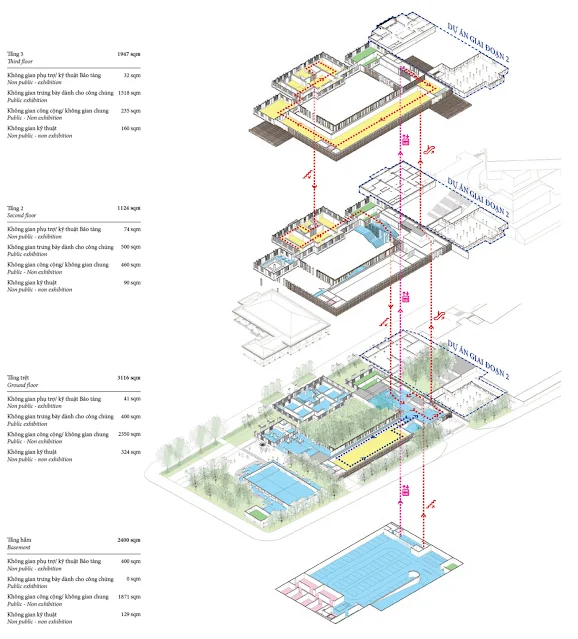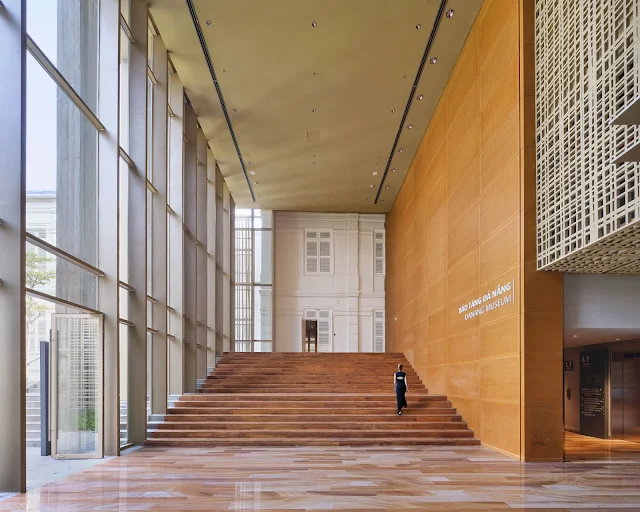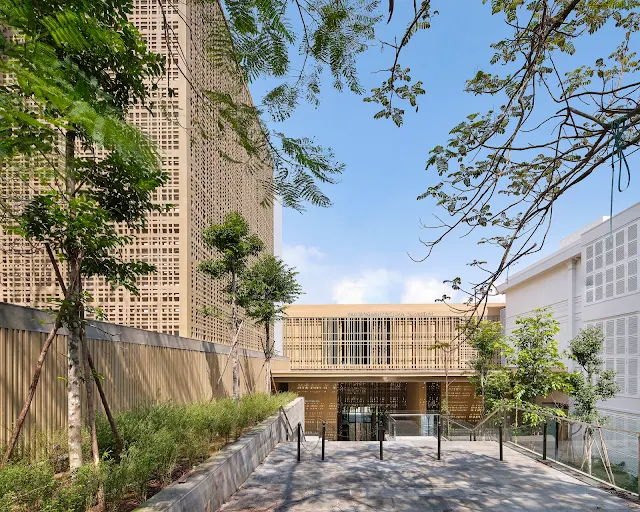Eduardo Chillida (1924–2002) was a renowned Spanish Basque sculptor and artist celebrated for his monumental abstract works that explore the interplay of space, form, and material. Born in San Sebastián, Spain, Chillida initially studied architecture before turning to art, a shift that deeply influenced his sculptural approach. His early works were figurative, but he soon embraced abstraction, creating large-scale pieces in iron, steel, wood, and stone that evoke a sense of harmony and tension. Often inspired by his Basque heritage and the natural landscapes of northern Spain, Chillida’s sculptures—such as his famous "Peine del Viento" (Comb of the Wind) installed in San Sebastián—blend seamlessly with their environments, inviting viewers to contemplate the relationship between solid matter and the void. His innovative use of materials and philosophical depth earned him international acclaim, including the prestigious Praemium Imperiale in 1991, cementing his legacy as one of the 20th century’s most influential sculptors.
TIME LINE
- September 2008 (2)
- December 2009 (1)
- January 2010 (1)
- March 2010 (2)
- January 2011 (13)
- February 2011 (6)
- March 2011 (3)
- April 2011 (6)
- May 2011 (2)
- June 2011 (20)
- July 2011 (72)
- August 2011 (35)
- September 2011 (10)
- October 2011 (73)
- November 2011 (11)
- December 2011 (6)
- January 2012 (6)
- February 2012 (1)
- March 2012 (5)
- April 2012 (1)
- May 2012 (2)
- June 2012 (3)
- July 2012 (5)
- December 2012 (1)
- July 2013 (1)
- August 2013 (1)
- September 2013 (1)
- November 2013 (1)
- February 2014 (1)
- April 2014 (1)
- May 2014 (3)
- July 2014 (1)
- August 2014 (1)
- October 2014 (1)
- May 2015 (1)
- August 2015 (1)
- November 2015 (2)
- January 2016 (1)
- February 2016 (2)
- March 2016 (3)
- May 2016 (2)
- July 2016 (1)
- September 2017 (1)
- March 2018 (1)
- May 2018 (1)
- August 2018 (1)
- January 2019 (1)
- May 2019 (1)
- September 2019 (1)
- February 2020 (1)
- April 2020 (2)
- July 2020 (1)
- September 2020 (2)
- October 2020 (1)
- November 2020 (1)
- February 2021 (3)
- April 2021 (3)
- May 2021 (11)
- June 2021 (4)
- July 2021 (3)
- August 2021 (1)
- September 2021 (1)
- October 2021 (4)
- January 2022 (1)
- May 2022 (9)
- August 2022 (1)
- September 2022 (1)
- October 2022 (2)
- December 2022 (1)
- February 2023 (2)
- March 2023 (6)
- April 2023 (10)
- May 2023 (18)
- June 2023 (40)
- July 2023 (86)
- August 2023 (21)
- September 2023 (14)
- October 2023 (39)
- November 2023 (25)
- December 2023 (18)
- January 2024 (15)
- February 2024 (12)
- March 2024 (4)
- April 2024 (9)
- May 2024 (17)
- June 2024 (18)
- July 2024 (21)
- August 2024 (28)
- September 2024 (17)
- October 2024 (17)
- November 2024 (22)
- December 2024 (17)
- January 2025 (9)
- February 2025 (9)
- March 2025 (13)
- April 2025 (10)
- May 2025 (11)
- June 2025 (6)
- July 2025 (22)
- August 2025 (3)
- September 2025 (8)
- October 2025 (8)
- November 2025 (9)
- December 2025 (2)
Sunday, March 30, 2025
Eduardo Chillida (1924–2002)
 Interior Designer: Life style - Comunity - Works
Mobile: (+84) 975675278
Email : tuannha.id@gmail.com
Interior Designer: Life style - Comunity - Works
Mobile: (+84) 975675278
Email : tuannha.id@gmail.com
Tuesday, March 25, 2025
Danang Museum design by studioMilou Singapore
The Department of Construction of Da Nang City awarded the First Prize to studioMilou Singapore Company for the architectural design of the Da Nang Museum, which was renovated from an office building. Ashui.com introduces to readers the content of this design plan
Old and New Architectural Strategies – The Appropriate Reuse
of the People's Council Building
The People's Council Building was built by the French government as one of the administrative buildings of Da Nang city. The building is used by the Vietnamese government as the People's Council Building. It is a very good example of the grand and generous architecture of the early 20th century and it has been well preserved by the Vietnamese government.
The Da Nang City Museum project will be a very successful example of a contemporary city-level museum, as well as a good example of the rational reuse of an existing building. Our design seeks to add a distinct part to the existing historic building, but will still respect the strictest conservation conditions because the design is non-invasive, removable, and very coherent.
The existing historic building will be carefully restored, with a new wing created, surrounding a peaceful courtyard with new landscaping. This new wing forms a circulation loop within the museum, a simple route for visitors, starting from the reception and ending at the souvenir shop and cafe. The new wing is designed with a porch with a modern architectural language and is open to all sides of the city, allowing visitors to flow from the New Square in front of the Assembly Hall to the library along the river. This means that the new Museum will further strengthen the city's pedestrian network and create an attractive destination on this side of the Square.
Architecturally, the design of this new wing clearly reflects the modern approach of architecture and does not try to imitate the existing historical structure of the building. It is designed as a transparent courtyard with columns and thin louvers that create a filter and help the interior space of the museum to have a soft light. It will be an attractive destination for the new pedestrian street area of Da Nang city center.
The material and colour palette of the project is simple and coherent. Behind the historic building façade, the building envelope will be restored to its original form. The new wing will bring a warm grey-wood colour scheme to the overall landscape, recalling the colours of rattan and the delicate designs of woodwork and weaving. The materials used for the new wing are; natural concrete with painted half-wooden formwork for the columns and structures, coloured fibreglass for the louvers, metal, glass, stone and local timber for the façade and interior. The project views reflect the colour and material strategy of the design quite well.
The old and new museums of Da Nang city have developed a successful museum model, blending exhibition exhibits, multimedia technology systems, internet-based technology and programs with the aim of easily reaching the children's community and school community.
The new museum on Bach Dang Street is an opportunity to optimize this model and connect the museum with the large pedestrian area along the Han River. In this new project, the museum will be the place to develop multimedia facilities, good interaction, based on 4.0 technology platform to create a complete experience, allowing visitors to immerse themselves in historical moments through 3D images, artifacts, and projected videos.
There will be two distinct parts to the project; the existing building, and the new wing behind the building. The existing building will include traditional exhibition spaces in a low-light environment (100 lux), mixing natural and artificial light to display the objects in the best conservation conditions with the lowest level of audiovisual intervention (small interactive screens, personal devices, etc.). The new wing will allow for a completely new exhibition environment with all artificial lighting, fewer objects and an environment filled with new audiovisual technology.
The tour route of visitors will go through the new wing first, which will simulate 6 periods of Da Nang city, each chapter is about 5 minutes long, visitors will be completely immersed in the projections and move freely to be able to interact with the main highlights of the exhibition. After 30 minutes in the new wing, visitors will be led to the museum space of the historical building to explore at their own choice and pace.
Therefore, the old and new characteristics of the project are reflected not only through the architecture but also through the exhibition content with traditional exhibition spaces in the existing building, and more technological exhibition spaces in the new wing.
The new Museum project will not only be a destination for
museum lovers, but also a community space for the entire city. The public
spaces, including the cafe, the museum lobby,
 Interior Designer: Life style - Comunity - Works
Mobile: (+84) 975675278
Email : tuannha.id@gmail.com
Interior Designer: Life style - Comunity - Works
Mobile: (+84) 975675278
Email : tuannha.id@gmail.com



